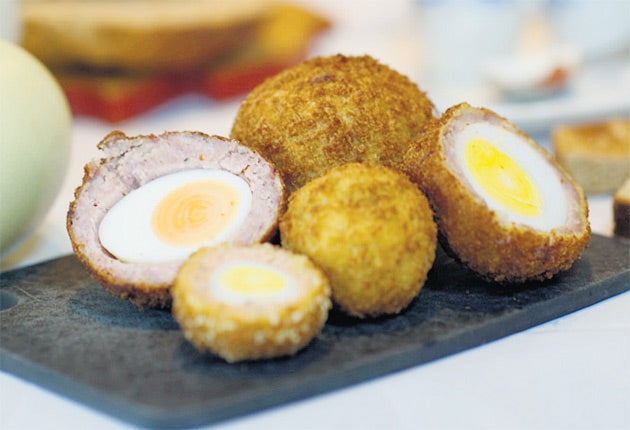Scotch eggs - let's go round again
It’s the snack that taste forgot – cheap and often downright nasty. But the scotch egg is back, and it’s gracing some of the country’s finest tables. Samuel Muston discovers that the meaty morsel has had a Michelin-style makeover

It has been rumbling for a while, a threatened return to fashionability of amost unfashionable food. Now with the arrival of two hot new restaurants on the London scene heralding this snack, and swanky food shops putting them front and centre, it is very much flavour of the month.
Yes, the scotch egg is back and it’s bigger, better and cleverer than before. Once the preserve of clammy school lunchboxes and motorway service stations, the snack has moved upmarket in recent years. Heston Blumenthal serves a warm quail egg version at his gastro-pub The Hinds Head in Bray, Claude Bosi makes them out of duck eggs at his newly opened Wimbledon gastropub, The Fox & Grapes, and Tom Kerridge, winner of the Great British Menu, makes his award-winning scotch eggs out of pureed crayfish. In fact, it seems that no self-consciously British restaurant is complete without one at the top of the menu.
“I remember being given one as a child and just nibbling off the meat and looking at the egg inside and thinking: ‘err, no thanks’,” says Kerridge, who serves them at his Michelin-starred restaurant The Hand & Flowers in Marlow, “but they are a good, traditional English product – it’s just a matter of taking them forward and lavishing a bit of attention on them.”
The snack’s rise can, in part, be put down to an increased confidence in traditional British gastronomy. No longer do we think of our cuisine seen as the poor relation of more celebrated continental relatives – chefs are increasingly looking to British history books for inspiration, rather than across the channel. Just take a look at Blumenthal’s menu at Dinner at the Mandarin Oriental which features dishes drawn from centuriesold cookbooks.
Jessica Gunn, features editor of the BBC’s Olive magazine, was one of the first to spot the scotch egg’s part in the revival, and included it in the magazine’s list of what’s cool for 2011. “It is definitely part of the British food renaissance. The notion of a scotch egg as a stale snack you pick up from a petrol station has begun to fade,” she says. “It’s been pimped up and has returned to its roots as a high-end snack.”
Yes, its roots. Created in 1738 by William Fortnum for his eponymous Piccadilly shop, it was first sold as an aristocratic “snack in a hanky,” according to Fortnum’s archivist Dr Andrea Tanner. Although the central London shop is now surrounded by boutiques and five-star hotels, in the 18th century the area was less salubrious and the store stood cheek-by-jowl with two coaching inns. The White Horse and Grey Hound were the starting point of most journeys to country estates in the south of England. “Imagine going in an unsprung, unheated carriage on an urgent journey to your estate in Cornwall. You wouldn’t want to keep stopping at coaching inns full of country bumpkins on the way, you’d want something tasty and hassle-free to eat as you were going. William Fortnum, a former royal footman, spotted this gap in the market and filled it with his egg in a meat jacket,” says Tanner. Then she explodes the common myth about the snack: “It has absolutely nothing to do with Scotland whatsoever. Scotch is just a corruption of the word scotched, meaning processed.”
By the latter decades of the 20th Century the aristo’s snackette had plummeted to almost terminal unfashionability. The only place to find it seemed to be in the lunchboxes of unfortunate children. Mass production cooking, the use of cheap off-cuts of meat, battery-farmed hens’ eggs and a general lack of love saw it fall to the status of national laughing stock. When Ricky Gervais wrote The Office he made the snack the trademark of the dull-as-dishwater character Keith Bishop. And the delusional, perennially dull Alan Partridge habitually bought them from his local BP petrol station.
Things slowly, surely started to change about five years ago, when Marks & Spencer started selling mini picnic eggs. A quarter of the size of the fist-like traditional variety and with a minced egg inside, they were an instant hit. “They were bang on the trend for snacking and really flew off the shelves,” says M&S product developer Julia Bradbury.
It was only a matter of time before chefs, always on the search for the new talking-point menu, alighted on the humble scotch egg. Restaurant watchers now feel it is reaching ubiquity and are already moving on to chicken kievs.
But the rest of us are still in love with the eggy treat. This year, Marks & Spencer says that year-on-year sales have gone up 40 per cent. And gourmet delis, such as Terence Conran’s Albion Caff in East London, report booming demand.
And if Fortnum & Mason’s new Easter range is anything to go by, they’re not going anywhere. From 22 April, if you have a spare £75, you can pop down to the shop and pick up a scotch egg with a twist: the 20kg beast is made from a full ostrich egg. Try fitting that in a hanky.
Join our commenting forum
Join thought-provoking conversations, follow other Independent readers and see their replies
Comments